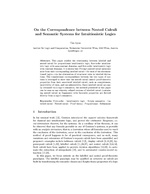On the Correspondence between Nested Calculi and Semantic Systems for Intuitionistic Logics
Aus International Center for Computational Logic
On the Correspondence between Nested Calculi and Semantic Systems for Intuitionistic Logics
Tim LyonTim Lyon
Tim Lyon
On the Correspondence between Nested Calculi and Semantic Systems for Intuitionistic Logics
Journal of Logic and Computation, 31(1):213-265, 2021
On the Correspondence between Nested Calculi and Semantic Systems for Intuitionistic Logics
Journal of Logic and Computation, 31(1):213-265, 2021
- KurzfassungAbstract
This paper studies the relationship between labelled and nested calculi for propositional intuitionistic logic, first-order intuitionistic logic with non-constant domains and first-order intuitionistic logic with constant domains. It is shown that Fitting’s nested calculi naturally arise from their corresponding labelled calculi—for each of the aforementioned logics—via the elimination of structural rules in labelled derivations. The translational correspondence between the two types of systems is leveraged to show that the nested calculi inherit proof-theoretic properties from their associated labelled calculi, such as completeness, invertibility of rules and cut admissibility. Since labelled calculi are easily obtained via a logic’s semantics, the method presented in this paper can be seen as one whereby refined versions of labelled calculi (containing nested calculi as fragments) with favourable properties are derived directly from a logic’s semantics. - Weitere Informationen unter:Further Information: Link
- Forschungsgruppe:Research Group: Computational LogicComputational Logic
@article{L2021,
author = {Tim Lyon},
title = {On the Correspondence between Nested Calculi and Semantic Systems
for Intuitionistic Logics},
journal = {Journal of Logic and Computation},
volume = {31},
number = {1},
publisher = {Oxford University Press},
year = {2021},
pages = {213-265},
doi = {10.1093/logcom/exaa078}
}
